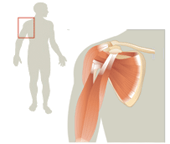Physical Therapy for Shoulder Pain Relief
Shoulder pain doesn't only occur in athletes, and it's not always a result of an accident. The fact is, you can get shoulder pain from doing household chores, lifting heavy objects, or sleeping the wrong way. One day, you might be helping your friend move furniture, and the next day you can barely get a shirt over your head.
If you experience shoulder pain while dressing, lifting, sleeping or carrying things, you should know about a clinically proven solution: physical therapy. Your therapist can help relieve your pain, restore movement, and recover strength without having to undergo surgery or use medications.
Physical Therapy: Your First Choice
It's a powerful form of treatment:
- Physical therapy has been shown to improve shoulder movement in patients with even the most serious of shoulder injuries.1
- It can help alleviate pain for people with long-standing shoulder issues.1
It's as effective as other treatment options but doesn't have side effects:
- Physical therapy is proven to be just as effective as corticosteroid injection and surgery for the treatment of shoulder pain.2,3
It has benefits that help you avoid future pain:
- Physical therapy programs include exercises that help build shoulder strength, which can help you avoid injury over the long term.
You can get relief fast:
- You don't have to wait in pain for an appointment: you can usually see a physical therapist within 48 hours of calling.4

More about Shoulder Pain
Visit our Medical Library for:
- Causes of shoulder pain
- Illustrations
- Possible treatments
- Additional web resources links.
Call us today and start feeling better tomorrow!
(734) 284-9533 or (734) 362-8200
References:
- Ainsworth R. Physiotherapy rehabilitation in patients with massive, irreparable rotator cuff tears. Musculoskeletal Care. 2006;4(3):140-151.
- Ginn KA, Cohen ML. Exercise therapy for shoulder pain aimed at restoring neuromuscular control: a randomized comparative clinical trial. J Rehabil Med. 2005;37(2):115-122.
- Haahr JP, Østergaard S, Dalsgaard J, et al. Exercises versus arthroscopic decompression in patients with subacromial impingement: a randomised, controlled study in 90 cases with a one year follow up. Ann Rheum Dis. 2005;64(5):760-764.
- CPTA Patient Survey, 2007.
NOTE: Physical therapy may not be for everyone, such as those who have a history of cancer, or severe systemic or neurological conditions; those who have experienced recent/significant unexplained weight loss, have structural deformities, have experienced a recent trauma resulting in fractures, or those who have used steroids.
Disclaimer: The information in this website is intended for informational and educational purposes only and in no way should be taken to be the provision or practice of physical therapy, medical, or professional healthcare advice or services. The information should not be considered complete or exhaustive and should not be used for diagnostic or treatment purposes without first consulting with your physical therapist, occupational therapist, physician or other healthcare provider. The owners of this website accept no responsibility for the misuse of information contained within this website.
